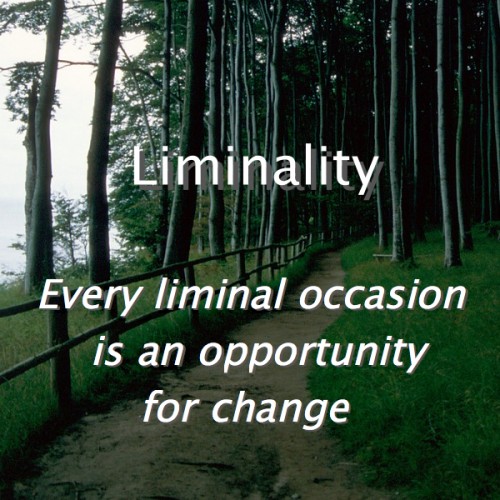Thomas writes, “I think we all have experienced a time in our lives when some tragic event has set us back on our haunches and left us gasping for air. My recent example was the death of my dear friend David Trembley, who was the author of much of the material represented in this site. I found the exercise, “Liminality” of great solace and support during my early grief. Even now, when rereading it, I find it to be helpful as I work through other changes and transitions in my life.” Here it is!
Liminality
The Essence
Liminality is a transition state outside and beyond our sense of the ordinary. It is like a doorway which stands between two distinct locales but has no real territory of its own.
Just Do It
In the bowels of the field house, the graduates are lining up. They help one another make last minute adjustments to robes, hoods, and mortar boards. The black academic gowns make everyone in look alike. The graduates occupy a peculiar in-between status as they begin to procession – neither students any longer nor yet fully fledged scholars. “Commencement” we call it. The ceremony is a rite of passage, a doorway through which they pass from the halls of academia out into the world. They move across the stage receiving their diplomas along with a new identity and a new definition of themselves. It will be the task of the commencement speaker to send the new graduates off into life inspired to occupy their new place in the world. ! Recall a powerful experience of being “betwixt and between.” Write it down.
Imagine That
Choose an object that includes open spaces as part of its construction; a metal folding chair is a good example. First look at the chair in terms of its component shapes. Next look at the open, or “negative,” spaces which are also part of its construction. Draw these negative spaces; let them define the chair without ever actually drawing the material parts — seat, back, legs. When you have finished, take time to appreciate your work.
Breaking It Down
Stand on the threshold of a doorway. As you stand, you are both in and out – in one place and out of another; both coming and going But since you are standing still you are also neither in nor out, neither entering nor leaving. Liminality is that strange in-between state of both/and . . . neither/nor . . . at the same time. It is a social situation that exists amid ordinary interactions. The most easily recognized liminal states are those that mark life transitions.
Funerals are solemn observances of the inevitable transition of death. Our daily routines are interrupted and special rituals are followed. We wear special clothes, often black; others care for us by bringing us food; we occupy a special place called a funeral home; our time is not structured in its normal way but is configured to meet hours of “visitation.” Friends and family convene to speak special words of condolence and eulogy. There are long-established patterns of tradition which dictate our activities: the wake, the funeral service, the interment, and the ceremonial meal after. The entire period is a passageway conducting us from the time before to the time after the death. The power of liminality acts to redefine us: I was the eldest child, but now I am an orphaned adult.
Every liminal occasion is an opportunity for change. We move through one identity and set of meanings to another. Forgoing liminal observances leads to a spiritual deficit. In current culture it is common to hear, “All that traditional junk doesn’t matter.” But every liminal event invites us into reflection about who we are and might be, how we belong to and with others and in society, and what were our old definitions and what will be the new ones shaping us now. Rites and traditions connected with the liminal events of our lives – weddings, funerals, baptisms, and so on – have developed as ways for us to process our experience and reassess our place in our families and society. Passing through liminality means stepping into a changed identity and life.
What’s Next?
We all have doorway events of liminality that denote and mark important changes in our lives. Paying attention to the underlying liminality will make the event more memorable and meaningful. The artist Rene’ Magritte once painted the portrait of a man by showing him defined by the space around him. The background wall is pierced by the man’s outline, so that the viewer sees blue sky and fluffy white clouds beyond. Liminal events work on us in a similar way, shaping and defining us by impinging their powers on us.
Think about how the next doorway of your life invites you to make successful transition. When liminality is expressed through traditional rites and observances, our spiritual awareness and understanding are heightened. We are helped to know the deep meanings of our existence. The birthday celebrates the growth and change of the kindergartener that was to the first-grader who is coming to be. The wedding ritualizes the joining of two separate persons into a synergy of newness and potential. In this way, all the liminal events of our lives shape us and move us from then to now, from old to new. If we emphasize liminal power, we stop going through the motions of mindless ritual. When we co-operate with liminality, we heighten the significance of turning points in our lives by infusing them with meaning.
